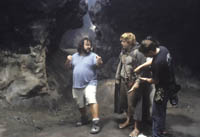Tourism lessons from Frodo and Co.

NEW Zealand's place in the opening credits of the film tourism industry has been assured since Kiwi director Peter Jackson’s The Lord of the Rings trilogy sparked a rush of Tolkien-loving tourists to the Canterbury Plains, Southern Alps and Mt Potts high country station, which showcased the beauty of filming locations such as Edoras, Helms Deep and the Misty Mountains.
The trend marked the coining of a new term, ‘the Frodo economy’, referring to films having a direct impact on the economy.
Other films that have generated similar tourism interest are King Kong, The World's Fastest Indian and The Lion, the Witch and the Wardrobe.
After the last-mentioned film was released, New Zealand Tourism even sent out newsletters and trade information promoting the locations now part of Narnia Aotearoa. These include the dark trees of Woodhill Forest, site for the White Witch’s Camp; Flock Hill in the Southern Alps, where director Andrew Adamson filmed the Great Battle of Narnia; and the ancient Elephant Rocks in the rolling hills on the South Island.
Meanwhile, a proposed co-production agreement with India means the country could show up in even more Bollywood movies (more than 70 Bollywood films, including the blockbuster Kaho Naa Pyaar Hai, have been at least partly shot here).
New Zealand Prime Minister Helen Clark said the aim of the film co-production agreement is to expand and facilitate film co-production to benefit film makers in both countries, and to develop cultural and economic exchanges.
This sort of state support means the country continues to draw filmmakers, who see the benefits of filming in a country with a strong artistic talent base, endless scenic vistas, and most importantly, which has cutting-edge film facilities.
The most famous of the new arrivals is probably Oscar-winning director James Cameron, who last month began filming the $200-million sci-fi vehicle for Sigourney Weaver, Avatar, about an ex-marine who finds himself trapped in an alien body in the midst of a war on an alien planet.
Among the new movies to be shot in the cinematic country are two vampire movies: Perfect Creature, set in the 1960s, and shot in historic areas of Oamaru, Dunedin and Auckland; and the Josh Hartnett-starrer 30 Days of Night, which recast New Zealand as Alaska, making use of plenty of shredded paper, Epsom salts, white blankets and other snowy substitutes. The film is adapted from a grisly novel about vampires invading an isolated town during the annual month of darkness.
But how does all this benefit tourism?
In the UK, Alnwick Castle, the country’s largest inhabited castle after Windsor Castle, received about 68,000 visitors before The Harry Potter movies – now, they get about 200,000 per season. Christ Church College at Oxford University attributed a 50 per cent rise in revenue to the same film series.
In New Zealand, according to an Australian Broadcasting Corporation report, the tourism boom following the premiere of The Lord of the Rings – The Return of the King film helped boost New Zealand tourism earnings by $175 million in the December quarter of 2003, while more tourists staying longer and spending more pushed travel earnings to $2.4 billion in the same period, up more than seven per cent on the previous year. Tourist numbers increased six per cent in the December quarter.
Like Austria and the UK before it, New Zealand now cottoned on to the fact that film tourism is a growing trend around the world, partly because of the rise in international travel, but also because of the tremendous growth of the entertainment industry.
How long will it before regional companies – and tourism bodies – begin offering tours to Abu Dhabi’s Emirates Palace, scene of The Kingdom?
By Prachi Parihar
